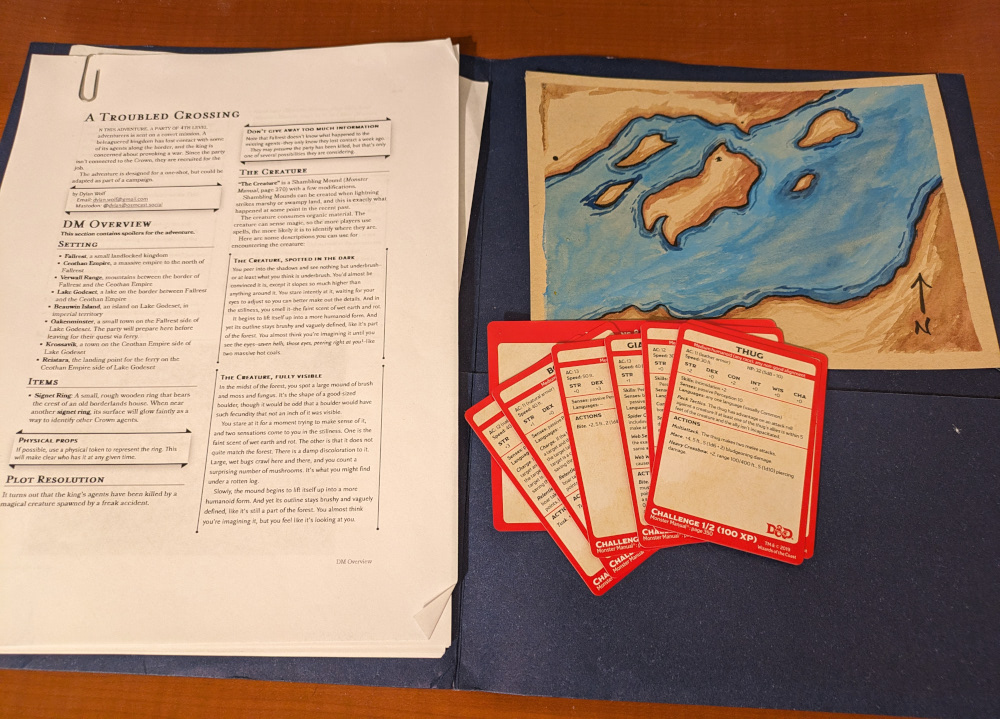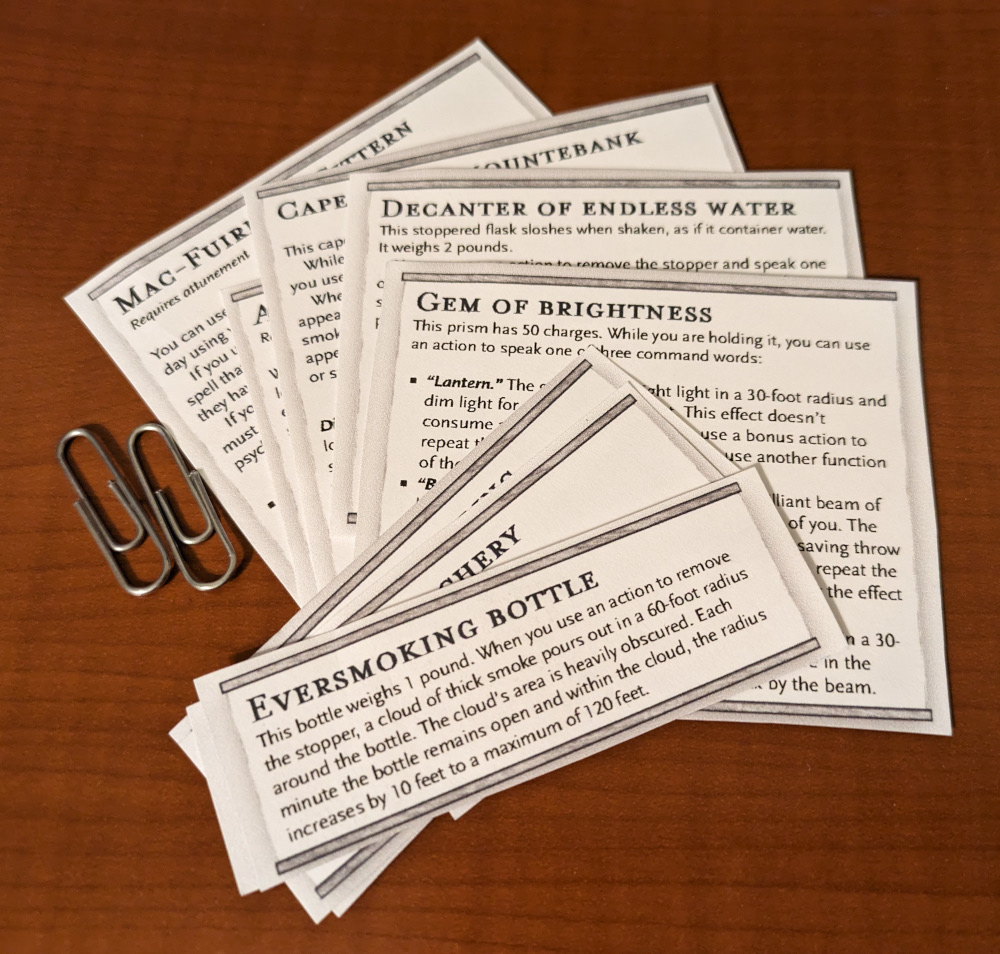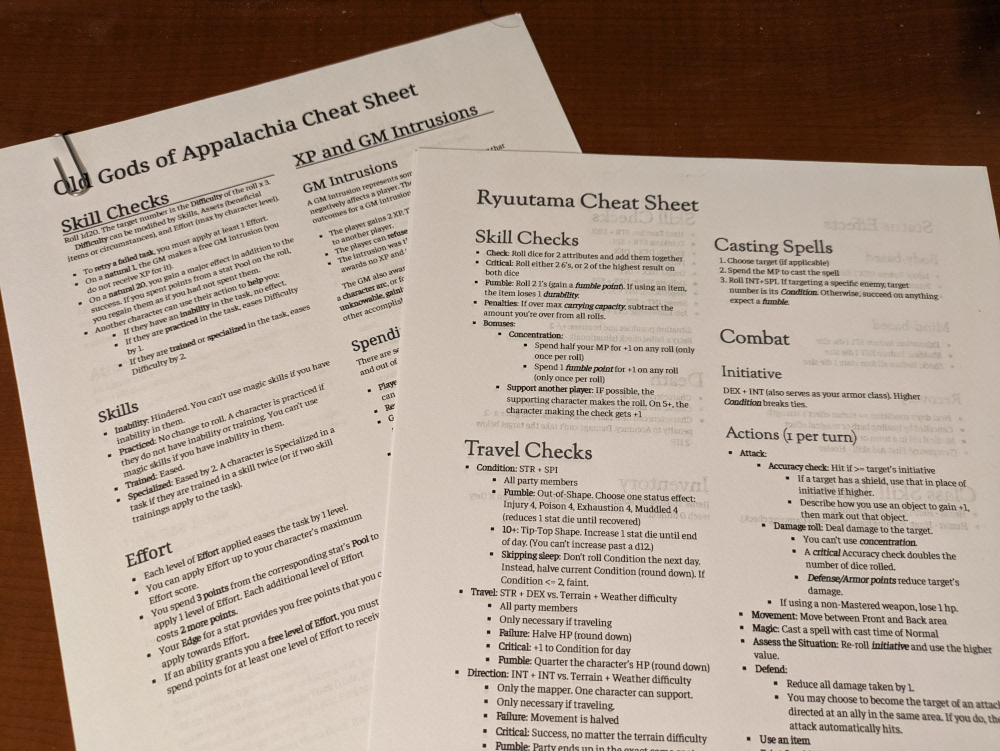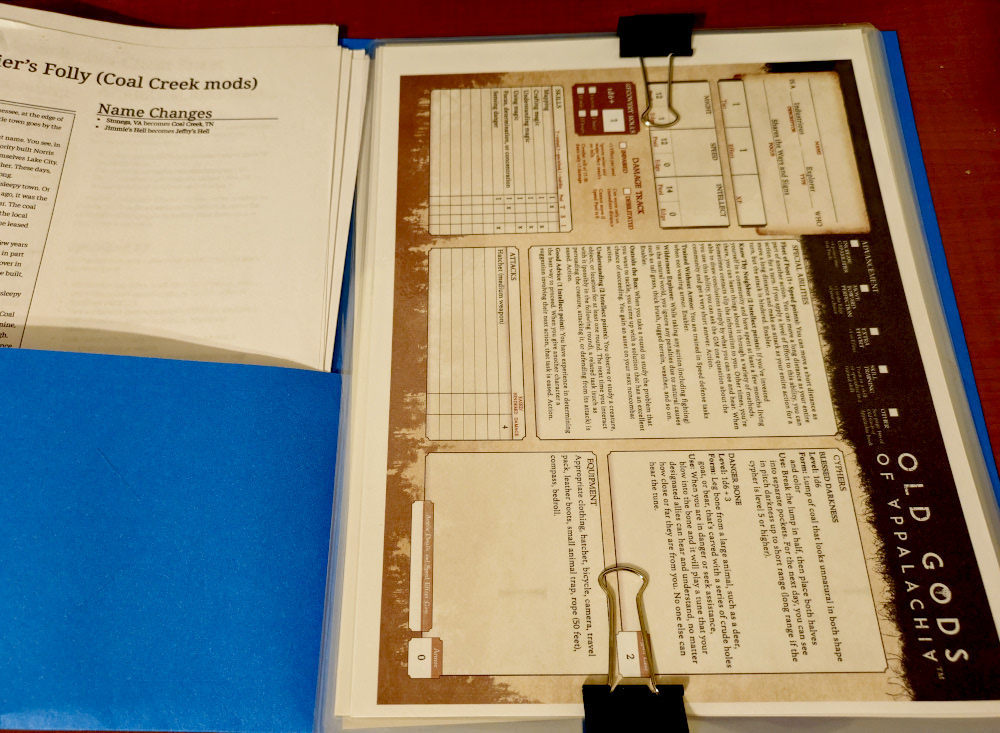I’ve written before about my theory of running game sessions at conventions in the context of my experience running Hamacon, but I’ve refined that process in the past year in hopes of building up a library of one-shots I can run on-demand.
When I prep a one-shot for friends, I try to give Future Dylan notes for stuff that’s hard for me to improvise in the moment (it’s much easier to imagine yourself in a scene when you’re not wrangling a group of people). That’s only a few steps removed from creating reusable adventures–so I started asking, why not take the extra step? (And that’s only a few steps removed from writing published adventures, which is an entirely different topic.)
My goals are:
- The module should be repeatable. It should only take minimal work to “refresh” it the next time it’s run.
- The module should be complete. Everything that’s needed should be in the folder (except for larger physical bits like dice, tokens, etc., which are usually common anyway).
- Above all else, the module preparation should respect players’ time. A four-hour gaming session carries a huge opportunity cost at a con. You should make good use of the time they’ve given you (and give them as much of it back as you can without sacrificing the experience).
Everything gets stored in a pocket folder
It’s smaller and more convenient than a binder, but can collect everything you need.
Each folder is a discrete packet of information–everything you need to run an adventure (aside from more physical stuff like books, GM screens, dice, battlemats, etc.) is in there, at your fingertips.
In some cases, I group up multiple adventures in the same folder. For example, I want extensive pregens and quick references when running Ryuutama, but the actual notes for my two adventures are relatively thin.
Adventure notes
I really like using Homebrewery for this. Writing in Markdown just feels natural–it’s easy to create headings, and thus easy to build an outline as you can fill in later. But if that seems complicated, I’ve used Google Docs too.
Essentially, you want to be able to print everything out concisely, and then clip the adventure together.
Maps
I’ve started using Inkarnate, but there are many other options out there. I’ve even painted maps as references in the past. These props go into the folder so they’re ready to set on the table when needed.
Monster and NPC cards
Gale Force Nine produces sets of D&D monster and NPC cards, which are just copies of the monster stat blocks. I don’t have a great solution for multiple adventures that use the same cards (that might go on the checklist; see below). For rarely-used monsters, I just keep those cards in the folder.
Homebrewery also has a template for monster stat blocks, so you can create your own reference cards as well. If you really want to get fancy, I’ve seen some RPG notepads in artist’s alleys at conventions.
Player handouts
If you’re handing out anything to players, clipping them together as necessary. For example, I have a D&D one-shot where I printed item stat blocks (again, from a Homebrewery template) on cardstock to hand to players when they find and identify magical items.
Cheat sheets, quick references, and GM screen inserts
I always make sure to prep some cheat sheets for games I expect to be teaching to newbies. Again, respect players’ time–this helps keep the game flowing smoothly, where asking questions or looking up details in a book might create pauses.
Don’t forget to have a reference for yourself, too. (I always forget little details, like what the travel checks are in Ryuutama.) You can find GM screens with empty pockets (such as “The World’s Greatest Screen”) to keep these quick references out of the way.
Pregenerated characters
I’m a stickler for having pregenerated characters available (which is probably the biggest step you can take to respect players’ time). There are a few exceptions, such as games with very minimal character creation, such as Be Prepared or other one-page RPGs. (Minimal means minimal–don’t kid yourself about how long it’s going to take, especially if you’ve got a lot of experience with it.)
For games that I don’t play as often, I put the pregenerated characters in the folder. In fact, I’ve laminated them so they can be reused–they’re too big for the folder pockets in that state, so I keep them in place with binder clips.
For D&D, I keep a separate binder of pregens from the WotC site, using sheet protectors and tabs. As I (or others) run games at different levels, I add it to the binder. Whenever they’re going to be needed, I go through and replace any sheets players took home.
Checklists
I list the title of the adventure(s) on the cover of the folder, along with a checklist of physical items I need to bring. For example:
- Books
- GM screens
- Meeples
- Battlemats or maps
- Dry/wet erase markers, and erasers for markers
- Tokens
- Index cards
Not every game needs the same tools, so I’m hoping this will make it easier to pull exactly what I need without having to give it too much thought.
My fear is missing some piece that’s vital to gameplay, like a grid battlemat for D&D or XP tokens for Old Gods of Appalachia. But overpacking is a risk, too–a lot of little things add up.
Build your catalog
As you build up a library of adventure modules, don’t forget to make a list so that you’re ready to offer or submit them. For example, I keep a list of one-shots on the site; I’ve also got a Google Doc that lists short campaigns (expected to be less than 5 sessions) in addition.
Make sure that your catalog has everything you need to make your pitch:
- A description of the game, suitable for submitting to a convention or event that will list it in its schedule. I’ve started noting the gameplay experiences (intrigue, dungeon delving, combat, etc.) in hopes that sets expectations properly (again, respect players’ time).
- Information about the system, if it isn’t for a commonly-known game like D&D. What does this system do differently? What types of stories is it focused on telling? You can add this in to the event description if necessary.
- Links to pregenerated characters, if you have them available on the internet. (For example, all of my Ryuutama pregens are in a Google Slides document.)
- Any other necessary information. Do you provide dice, pregens, etc? What should players have ready before they play? How long do you expect it to take (if it’s not aiming at a 4-hour time block)?
Ultimately, the goal with this set up is that you can have a shelf full of adventures ready to go, and easily package up the larger physical tools that go along with each game.




